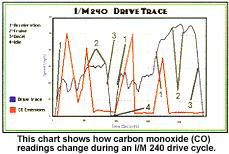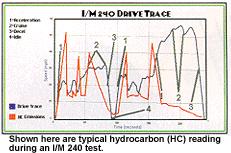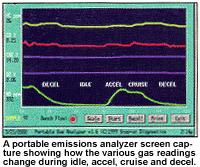Advertisement [ ? ]
Site Links
- Lease Calculator
- Advertise on 10,300+ pages
- My Car ongoing Review
- Members' Chat
- Cars For Sale
- Car Dealers
- Honda "Fit" Manual
- Hyperflex Bushings
- For Sale
- Fix your Car
- Car Manuals
- other manuals - Reference Materials
- DIY Repairs
- Articles
- Video
- Link with Us
- Search Help
- Code your Mac!
- Fly, race, anything R/C
- DIY repair guides
- Z-Seven
- Mechanic's Blog
- Free Files
Emissions Testing: Exhaust Analysis
Most people don't take the news very well when told their vehicle just failed an emissions test. For many motorists, emissions testing is an inconvenience and a hassle. They don't like it, but the law is the law. Emissions testing is required in many areas to minimize the impact of automotive pollutants on our environment. Emissions also affects engine performance and fuel economy (a benefit many motorists overlook). When a vehicle fails a test, therefore, it often means the vehicle has an engine performance problem as well as an emissions problem.
The law says vehicle owners are responsible for having their vehicles repaired if their vehicle fails to meet the minimum cut points for the model year in question. Many states have waiver provisions that limit the amount of money a motorist has to spend in an attempt to repair an emissions failure. Even so, the dollar amount may be as high as $450 depending on the model year of the vehicle. And, if tampering is involved (emission controls have been removed or rendered inoperative), there may be no waiver limit on the repairs!
The fix for an emissions problem may only require some relatively minor adjustments or repairs (changing an air filter or spark plugs, fixing a vacuum leak, replacing a defective sensor, etc.), or it may require more extensive repairs. An engine with a burned exhaust valve, for example, is going to blow hydrocarbons out the tailpipe until the head is pulled and the valve problem is fixed. The same goes for other internal engine problems such as broken rings, cracked pistons, worn or scored cylinders, etc. that require major repairs.
Many emission failures are relatively simple to diagnose because the cause is fairly obvious. Other times, the cause is less obvious and not so easy to diagnose. Sometimes the cure can only be found in a vehicle manufacturer's technical service bulletin (TSB). Some of these problems turn out to be calibration glitches in the engine management software that requires flash reprogramming the powertrain control module (PCM) or replacing other components. To find these kinds of emission failures, you need access to a TSB database such as that available through a computerized repair information system such as Alldata.com.
Elevated hydrocarbon (HC) emissions usually indicate ignition misfire due to fouled spark plugs or a bad plug. But high HC emissions can also be caused by burned exhaust valves (check compression), lean misfire (check for vacuum leaks, low fuel pressure or dirty injectors), or rich fuel conditions (fuel saturated carburetor floats, excessive fuel pressure, leaky injectors or a dead O2 sensor).
High carbon monoxide (CO) emissions are a telltale sign of a rich fuel mixture. On older carbureted vehicles, fuel-saturated plastic floats, incorrect float settings, leaky power valves and misadjusted chokes are often responsible for the rich mixture. On newer vehicles with feedback fuel controls and fuel injection, leaky injectors, excessive fuel pressure and sluggish or contaminated O2 sensors are all possibilities to investigate.
Harder to diagnose are elevated oxides of nitrogen (NOX) emissions. Causes here may include a defective EGR valve, EGR vacuum solenoid or motor, plugged EGR ports in the manifold, over-advanced ignition timing or engine overheating.
In areas with I/M240 programs that require an evaporative emissions check, problems with the charcoal canister, purge valve and evap plumbing may cause a failure. A leaky gas cap is an often-overlooked cause for leaking fuel vapors into the atmosphere.
EMISSIONS FAILURE
Since loaded mode testing is the most demanding in terms of emissions performance, let's see what happens when a vehicle fails this type of emissions test.

A loaded mode test uses a dynamometer to simulate actual driving conditions. During the test, pollutants are monitored during idle, acceleration, cruise and deceleration. The pollutants are typically measured in grams per mile (gpm) rather than percentage of concentration (%) or parts per million (ppm) which makes it hard to translate ordinary 4 and 5-gas analyzer readings into gpm readings. Software is available that can do a fairly accurate conversion using additional inputs such as vehicle weight and engine displacement. Without the proper software, there's no way to know if a vehicle's HC, CO and NOX readings are within the required gpm limits or not.
In any event, the motorist is usually given a printed form that indicates which portion of the test their vehicle failed and by how much. The form may also provide additional diagnostic readings such as carbon dioxide (CO2) and/or oxygen. Some forms also plot the data on a graph so you can more easily see which part of the test produced the highest levels of pollution.
In an I/M 240 test, the vehicle is run on a dynamometer for up to 240 seconds. The drive cycle is broken into two phases. Phase One lasts 93 seconds. The test starts at idle, includes two minor accel/decel curves before attaining a "low speed cruise condition," then decels to a stop. Phase 2 includes three high speed cruises: One at 47 mph and two cruises in the 54 to 56 mph range. During the drive cycle, the emissions are gathered and recorded second-by-second.

The I/M 240 software calculates the total amount of HC, CO and NOX produced for each portion of the test. If emissions are low enough during the first 30 seconds of the test, the test may be ended early with a "fast pass" issued. But if emissions are high or borderline during the first part of the test, the test will go the full duration to determine an ultimate pass or fail grade.
In states that use a simpler "hump" drive cycle, the vehicle accelerates at a given rate from idle to a predetermined cruising speed (30 to 33 mph), holds at cruise for a given number of seconds, then decels back to idle.
There are some preliminary checks that should be made any time a vehicle with an oxygen sensor feedback control system fails an emissions test:
Always verify that basic engine compression, vacuum, fuel pressure and ignition timing are normal;
The air cleaner is clean and unobstructed;
The engine is running at normal temperature;
All emission control devices are installed and appear to be connected properly; and
Is the "Check Engine" light on? If the light is off, cycle the ignition to make sure the bulb is not burned out. If the light is on, there are stored trouble codes that can help you make your diagnosis. If the computer doesn't use LEDs to display the code, a scan tool or other diagnostic tester will be needed to access the codes.
On 1995 and newer vehicles with OBD II, the OBD II system is usually capable of detecting most of the problems that can cause an emissions failure. If the light is off, check for history codes that may reveal a part problem.

IDLE EMISSIONS
A vehicle that has sharply elevated HC or CO emissions at idle will usually have a noticeable misfire and/or rough idle. The most likely causes here would be:
Fouled spark plug(s);
Shorted spark plug wire(s) or defective plug boot(s);
Vacuum leak;
EGR valve stuck open;
Burned exhaust valve;
Misadjusted throttle body air/fuel mixture; or
Misadjusted carburetor idle mixture.
An extremely rich fuel condition can also cause elevated HC and CO at idle, while an extremely lean condition will only cause HC to rise abnormally. A leaky EGR valve can act like a vacuum leak and cause a lean misfire at idle.
HC and CO will be somewhat higher as a cold engine warms up because the fuel system may still be running in open loop. Until the engine reaches a predetermined temperature and/or the oxygen sensor gets hot enough to produce a good signal, the PCM will supply a relatively rich mixture while the system is in open loop. A faulty thermostat that is stuck open or a defective coolant sensor may prevent the system from going into closed loop.
NOX emissions are always lowest during idle and decel because that is when engine load and combustion temperatures are lowest.
ACCELERATION EMISSIONS
During acceleration, the engine momentarily drops out of closed loop and receives a richer fuel mixture for more power. During this time (depending on the system), the MAP or Airflow Sensor and the TPS sensor play critical roles in controlling the fuel mixture.
Most fuel-injected engines have either a throttle position sensor or switch that indicates when the engine is at idle. When this device indicates that the engine is no longer at idle, the on time of the injectors is increased to temporarily richen the fuel mixture. The same thing happens any time the engine comes under load and manifold vacuum drops. The MAP sensor tells the computer the engine is under load, and the computer responds by adding more fuel.
It is normal to see some spikes in CO during acceleration, but unusually high CO readings indicates that the fuel mixture is too rich. Possible causes might include:
Flooded charcoal canister or a leaky purge valve;
Leaky power valve (older carbureted engines);
Defective mass airflow (MAF) sensor, manifold absolute pressure (MAP) sensor, or vane airflow meter (VAF); or
Defective throttle position sensor.
If the feedback fuel control system is working properly and there are no apparent sensor or purge valve problems, the catalytic converter may be contaminated or not functioning.
Elevated HC readings during acceleration indicate ignition misfire under load. The causes could be:
Defective knock sensor;
Weak ignition coil(s);
Excessive resistance in spark plug wires;
Arcing inside the distributor cap;
Worn, fouled or incorrectly gapped spark plugs;
Over-advanced ignition timing; or
Lean air/fuel mixture.
NOX readings will rise sharply during acceleration and will peak a few seconds after the cruising speed is reached. If the EGR system fails to recirculate exhaust back into the intake manifold, combustion temperatures will rise causing an increase in NOX. The higher temperatures may also cause some detonation (spark knock) to occur, which may be audible when the engine is under load. Causes of elevated NOX emissions during acceleration include:

Defective EGR valve;
Leaky EGR valve plumbing or control solenoid;
Carbon deposits in EGR manifold passageways;
Carbon buildup on pistons and in combustion chamber;
Over-advanced ignition timing;
Defective knock sensor;
Engine overheating (check thermostat, fan, coolant level);
Exhaust restrictions.
CRUISE EMISSIONS
At cruise, the engine is lightly loaded and running at high rpm. Under these conditions, HC and CO should be low if the oxygen sensor and feed back control system are working properly, and the catalytic converter is in good condition.
High CO readings during cruise indicate a rich fuel condition. Causes here may include:
Defective O2 sensor;
Exhaust leaks upstream of the O2 sensor (check manifold gaskets and air plumbing connections);
Defective AIR pump or diverter valve (also loose or damaged air pump plumbing);
Defective MAP, MAF or VAF sensor;
Float level and operation (older carbureted engines); and
Power valve operation (older carbureted engines).
High HC during cruise would indicate a steady misfire or loss of compression (leaky exhaust valve).
DECEL EMISSIONS
When decelerating, the engine will typically either lean out the fuel mixture or shut the fuel off completely (some fuel-injected engines). The computer typically uses inputs from the Vehicle Speed Sensor, TPS, MAP and/or Airflow sensors, and engine rpm to determine when this occurs. When the throttle closes and manifold vacuum shoots up, the computer cuts back on the fuel. Normally, HC, CO and NOX emissions drop during deceleration because the engine is no longer under load and is receiving little or no fuel.
If CO emissions remain high during deceleration, the engine is receiving too much fuel. Causes may include:
Defective decel valve (older carbureted engines);
Leaky fuel injectors; and
Faulty VSS, TPS, MAP or airflow sensor.
Adapted from an article written by Larry Carley for Import Car magazine
Back to Driveability Diagnostics Emissions | Back to Info Main Page
Total messages: 1
